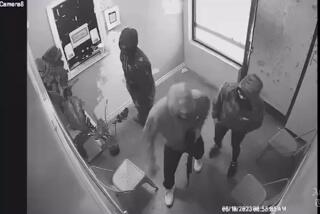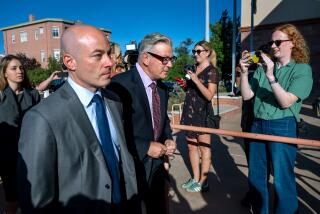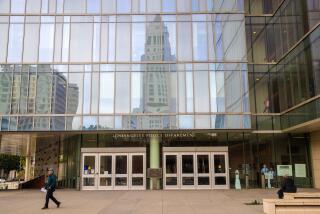Officer Testifies He Did Not Plant Gun on Gang Member
Displaying by far the sharpest recall of any LAPD witness at the Rampart police corruption trial, defendant Sgt. Brian Liddy testified Tuesday in acute detail about an April 1996 raid at which he and other officers are accused of framing a gang member with a planted gun.
Liddyâs description of the arrest of 18th Street gang member Allan âCleverâ Lobos essentially repeats the story he gave in police reports--a version of events that prosecutors charge is perjury.
Prosecutors also allege that Lobos was framed, among other overt acts supporting the most serious charge--conspiracy to obstruct justice--against the four suspended Rampart officers on trial in Los Angeles Superior Court.
Lobos is among more than 100 defendants whose convictions have been overturned in the yearlong Rampart scandal. He was listed as a prosecution witness but was not called after his lawyer indicated that he would invoke his rights against self-incrimination if defense attorneys questioned him about unsolved gang murders.
It was an April 21, 1996, gang murder that brought a clique of the 18th Street gang, the Columbia Street Locos, to a parking lot near 4th and Hartford streets five nights later, Liddy testified. An 18th Street gang member named âFrostyâ had been killed during a gun battle between rival gangs engaged in a tagging war, he said.
Liddy and partner Paul Harper encountered the informal memorial service for Frosty as they scoured known gangster hangouts, Liddy testified.
In his testimony, Liddy, a burly 39-year-old, recalled even the tiniest of details--including the exact route that he took to the parking lot that night more than four years ago.
âIt was a hot spot for gang activity,â he said. âYou name it, it goes on in that area.â
Gang members began to scatter as he drove in, lights off, Liddy said. Two of them--âRascalâ and âDiabloâ--sprinted toward a hole in the fence and got away. âI knew they had me beat,â Liddy testified.
But a third gang member, later identified as Lobos, ran and ducked among parked cars.
âI remember seeing a gun in his right hand,â Liddy testified. âIt was a semiautomatic pistol, a dark gun.â
He added, under questioning by his attorney, Paul DePasquale, that the fleeing man never pointed the gun at him.
Liddy said he yelled to his partner, Harper, that the suspect had a gun. The gangster crouched between the cars. A few minutes later, as a police helicopter aimed a spotlight on them, the suspect stood up and raised his hands in surrender, Liddy testified.
The gun was later recovered by a patrol officer who searched the area, according to earlier testimony.
Rafael Perez, a disgraced former Rampart officer caught stealing cocaine from police evidence lockers, told authorities that he lied when he reported recovering the gun, and that Liddy, Harper and Sgt. Edward Ortiz conspired to plant the weapon, then to accuse Lobos of carrying it.
But Perezâs value as a witness came under question when a former girlfriend implicated him in murders under investigation by federal authorities. Like Lobos, Perez indicated through his lawyer that he would assert his 5th Amendment rights if defense attorneys questioned him about murders.
As a result of Perezâs allegations, Liddy, Ortiz, 44, Harper, 33, and Michael Buchanan, 30, are being tried on charges they conspired to frame suspects, plant evidence and lie on police reports and in court.
Their common goal, according to prosecutors: to wipe the streets clean of gang members by any means possible.
The first defense witness was an accident reconstruction expert, who focused on another incident in which Liddy and another partner, Buchanan, are accused of lying about being hit by a pickup truck driven by fleeing gang members.
The expert, retired Cal State Northridge physics professor Mortimer N. Moore, told jurors that the physical evidence was consistent with Buchanan and Liddyâs being struck by a pickup moving about 16 mph.
Moore also testified that he agrees with a report by the prosecutionâs expert, Indiana University medical school professor Dean A. Hawley, that the officersâ injuries were consistent with being hit by a truck.
Buchananâs knees were scraped, but the wounds contained no gravel or dirt from the ground, Moore said. Liddyâs sprained ankle and twisted back were consistent with being knocked off balance.
Hawley was not called by prosecutors. But the defense managed to turn an absent prosecution witness into a witness of its own.
Deputy Dist. Atty. Anne Ingalls spent most of the morning session trying to show that Mooreâs conclusions were wrong and that the officersâ version was fabricated.
But Moore testified that his opinion was supported by Hawley, the prosecutionâs expert. Both experts, Moore said, were âin perfect agreement with Buchananâs testimony.â
Prosecutors contend that Buchanan and Liddy were never hit, based on the testimony of a few gang members and associates who say they didnât see anything.
But, as Buchananâs defense attorney Harland W. Braun had repeatedly pointed out: âSaying you didnât see something is not the same as proving it never happened.â
More to Read
Sign up for Essential California
The most important California stories and recommendations in your inbox every morning.
You may occasionally receive promotional content from the Los Angeles Times.










